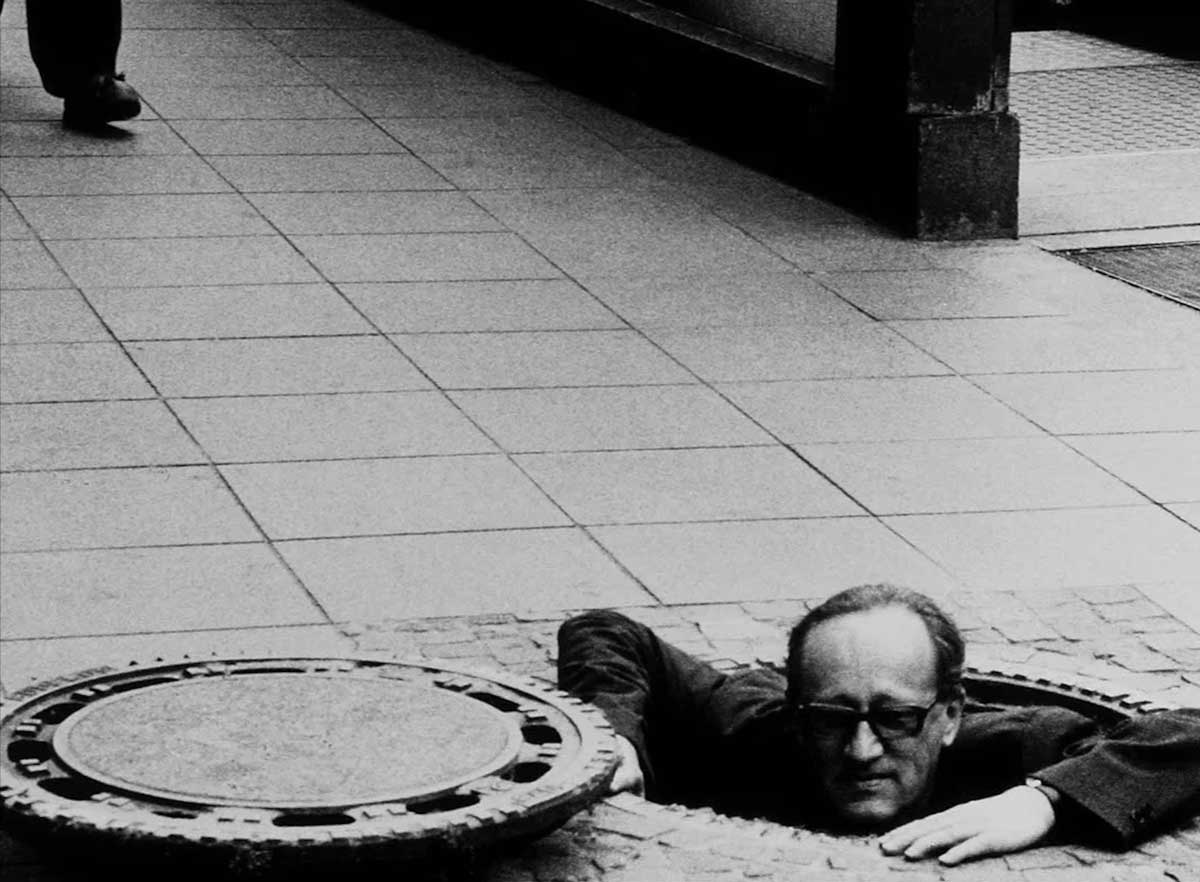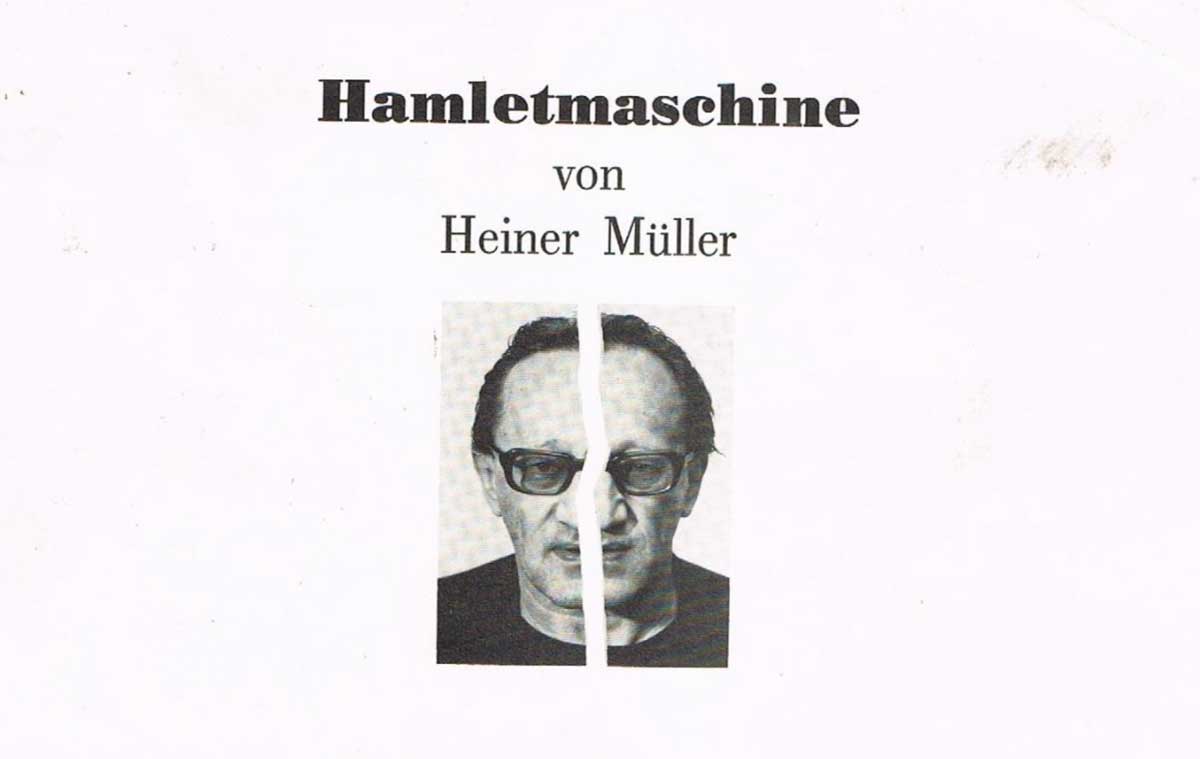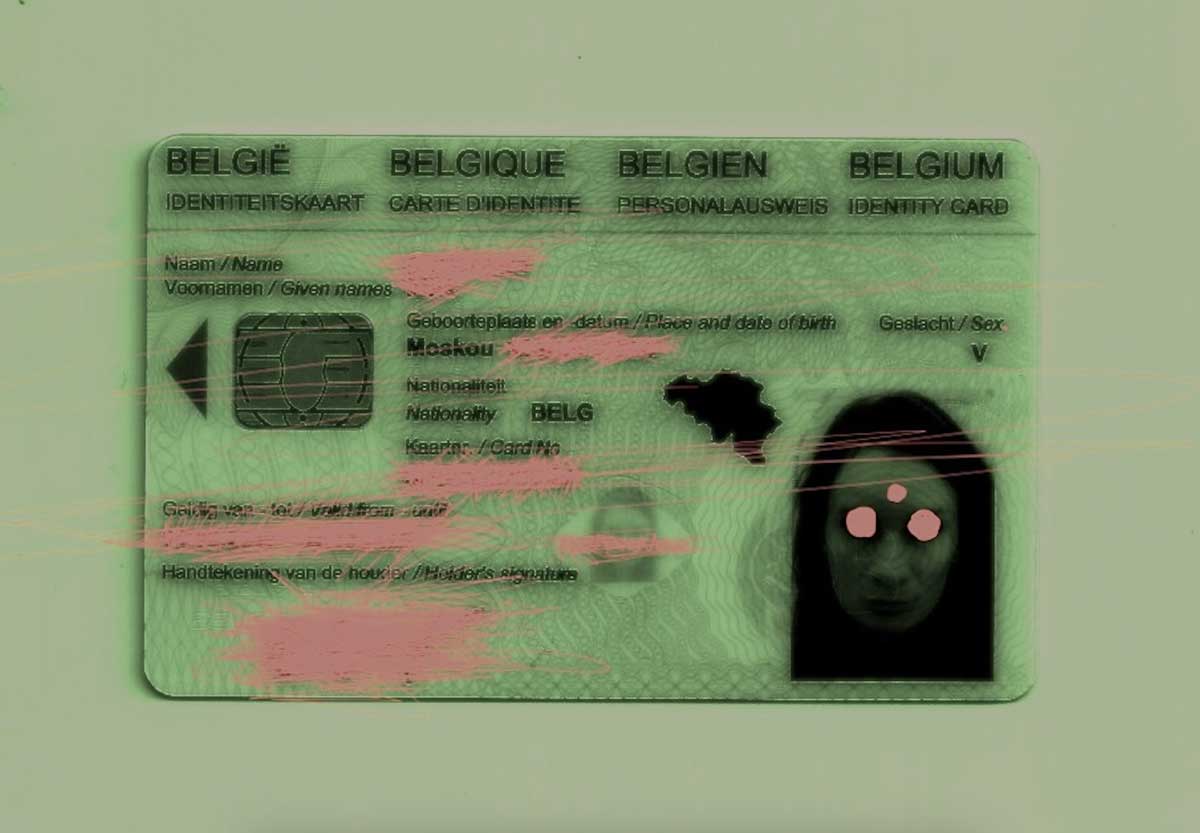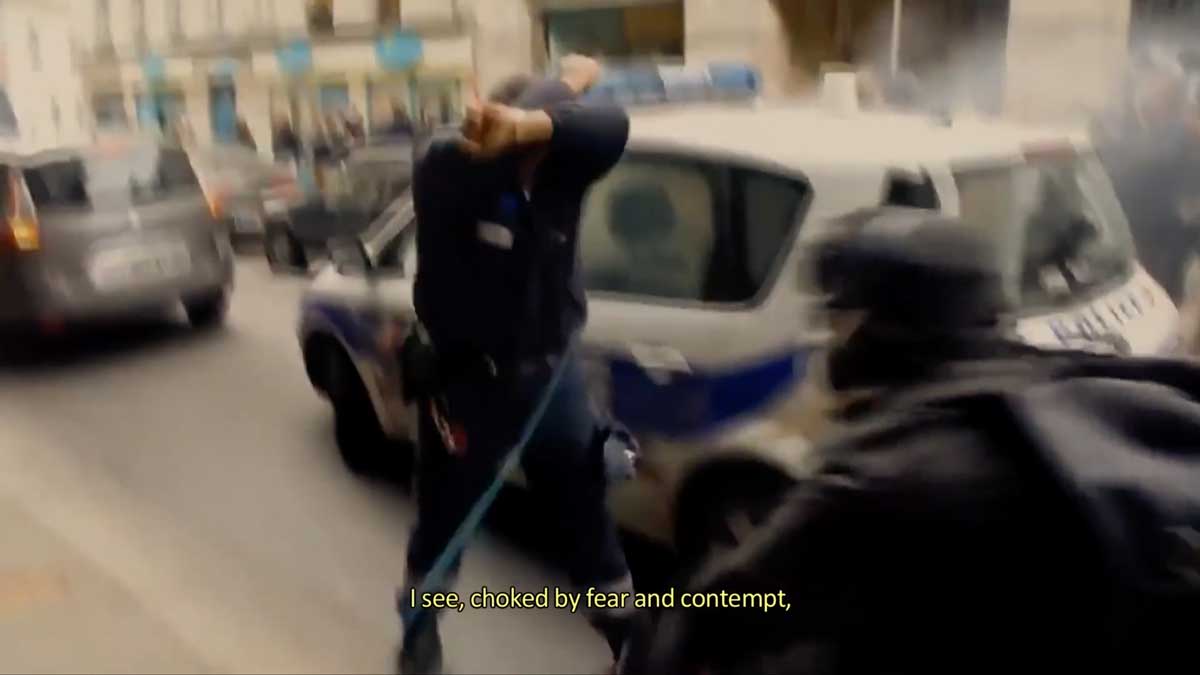106 — December 2024




LETTER TO T.H.
Or what is the emphasis of an essay
Ira A. Goryainova
Dear T.H.,
We don’t know each other personally, but by coincidence we have met indirectly. We. You, a documentary filmmaker. Born in the GDR, Berlin, 66 years old. Noble and artistic background. More than 10 documentary feature films to your credit. Teaching positions at several European film and art academies. International recognition. They say that your latest film is a masterpiece. Well, congratulations.
Let me briefly introduce myself too. I was born in 1984 in Moscow, in the former Soviet Union. We practically originate from the same ‘political bloc’. I remember when I went to the first grade of primary school, we had to wear brown school uniforms and, on celebration days, girls had those huge semi-architectural structures made of bows braided on their heads, reminiscent of your German pastry, you know? Pretzel. It was very close to the collapse of the Soviet Union, or had it already happened? – I don’t remember, but my mother suddenly started to dress me in blue jeans instead of that brown uniform. That’s why teachers and other kids looked at me askance and in an unfriendly way. The uniform was sort of cancelled, but the bulk of the children continued to wear it by inertia. Jeans… Since then I have generally disfavored this attire, for hostility is always difficult to endure. But I digress! In 1991, the USSR fell apart. I moved from the Soviet Union to Russia. The address, though, remained the same. Given your age, your place of birth, and your biography in general (I read it online the other day), I am sure you followed with interest, if not awe, what was happening. Until then, the world was divided in two by an iron curtain, like the concrete wall in the middle of your city not so long before that. The border. Do you know I am writing a book about borders? A coincidence. And then suddenly the border dissipated like a waking dream. Well, at least on paper. The borders dissipated, and we – you and me – stopped belonging to the same bloc.
In 2002, I entered university to study law. If you had known me personally, you would have been surprised. But otherwise, it’s just a biographical fact. A legal education is the teachings of laws and boundaries, of laws that are clearly written out, and of the mastery of staying within their borders by overcoming them, but by no means breaking them. Six years later, I graduated and received a master’s degree, never to become a lawyer, or never to be connected with the field of law (writing these lines now makes me quite amazed by this word: law. Try pronouncing it yourself: law. Law! – somehow empowering, isn’t it?). But the most interesting thing about this episode is my thesis: on the subject of copyright law. It happened that a year or two after my graduation, I crossed another border and moved to Belgium. At the new address I went for a second degree in higher education, and in 2016 I received a Master of Arts degree in documentary filmmaking. Here the geographical and professional chasm between you and me could have melted away like the Iron Curtain or the Berlin Wall, but no, it only opened up. My graduation film, The Ruins of Europe, is a settling of scores with the law. The Law! Specifically, copyright law. Wouldn’t you agree that it’s a vehement and symbolic gesture: as a copyright lawyer, to make a graduation film in violation of every possible copyright law? To leave the past behind. To move from the realm of boundaries into the realm of art. Initiation. The Ruins of Europe is half made up of so-called “found footage” or “archives” or – as I myself prefer to look at this phenomenon of our digital age – fragments out of the stream, the drift of moving images, which is ceaselessly growing like a devouring monster of the Internet Dasein. In the film industry there are many terms to describe this kind of film: montage film, found footage film, archival film, essay film, collage film. As a technique of contemporary art, collage is a widespread method of working with reality, with history, with documents and artefacts. Arte factum. A kind of commentary with a new perspective as a goal by re-configuring and re-contextualizing fragments of already existing views. One plus one equals three. When students or fellow filmmakers come to me with questions about the legal aspects of working with archives and found footage, I always draw their attention in the first place to collage as a form of contemporary art.
Thus, in the credits for The Ruins to Europe I put the following disclaimer:
This film partly contains copyrighted video fragments belonging to third parties. If you are a copyright holder and experience any kind of problem with the presence of your audiovisual material in this work, please contact the filmmaker. This film is not pursuing commercial goals whatsoever.
And what do you tell your students?
One of the most exciting moments for me was an invitation by the Heiner Müller Gesellschaft in Berlin. That is the moment when our paths indirectly crossed. Let me remind you: The Ruins of Europe is based on Müller’s play Die Hamletmaschine. The film was to be shown at the Deutsches Theater, and you were invited to moderate the discussion after the screening. I remember you hadn’t seen the film yet, but you had already said to the organizer that the screening should not take place in the big theatre hall, but in the bar at the entrance. And that it would be better for me to speak not in English, but in my native language, and accordingly, they should invite an interpreter from Russian to German. Late, the organizer of the event sent me a rather alarming letter. She wrote that you had called her the other day and were terribly upset. You had told her that I was not just using archives, but using footage from other people’s documentaries, that I should be diligent about immediately putting all the names in the credits, and that you were going to contact the directors of those films if my film would be shown in the Deutsches Theater, which would certainly cause legal problems. A little later the organizer of the event informed me that the directorate of the theater had arranged an urgent meeting about the admissibility of programming my film. I’d like to comment with a quote from your own film:
‘Nimm das nicht so tragisch; sei doch nicht so schrecklich deutsch!’1
I, however, became encouraged and even cheered up. After all, borders, frontiers and crossing them is my lyric. I spent the entire day calling my friends and telling them about you, dear T.H.! “And then he said that I should be diligent about immediately putting all the names in the credits, and that he will inform all of the directors, etc. etc.” Have you ever had that feeling? On the one hand, the truth is on your side and giving you some sense of empowerment, but on the other hand, it is of little use, for you are opposed to a man of authority, success, of noble and artistic origin. As proof of my guilt, you sent a link to the film of your “colleague” from whom I was “stealing”. However, the release date of that film was a few months after mine was completed, and the film (a great one, by the way!) consisted of several shots taken from a wonderful and very popular video-sharing site. The actual footage was replicated by thousands of accounts. Nobody cared to credit the author, nor your colleague: neither the TV channels, not the replicators. For using and re-using, and re-re-using, is the way the devouring monster of the Internet Dasein exists. Forgive me this tautology.
Later, it turned out the real reason for your indignation was that I had used Heiner Müller’s theater piece not according to the canon. Apparently, there are rules to follow in the theater world. Or, let me put it more simply, because I dared to make a film based on Müller’s play tout court. Jealousy? Ownership stamped under nationality in a passport? Authority regarding exclusive usage? Authenticity? I have heard that Müller was a family friend of yours.
Students often ask me if I’d ever had problems with uncleared footage, and I tell them: just once.
Yesterday I decided to watch your masterpiece. The VOD platform says that your early films “dealt with social phenomena in the GDR and the country’s bureaucratic apparatus.” The bureaucratic apparatus? Did you turn into something that you yourself struggled with? I start to watch the film, though. Static shots, forest, folklore. Black and white photographs follow one after another. Deutsches Volk. Blut. Krieg. Die Liebe. Meanwhile, two crows have landed at my window under the roof, waking me up from the slumber your film had cast me into. I paused it and went to film the creatures. When the crows flew away, I returned to the screen. Your voice monotonously read out letters from your family, your ancestors, your country, your history. You treat your own documents with such painstaking care and scrupulousness. Your eagerness to destroy my film, on the other hand, is exhilarating.
Later, I accidentally stumbled upon your film about Heiner Müller and I really liked it. I will send it to my friends, and then I will tell them again: “T.H. called and was very upset. He said that I should be diligent to immediately put all the names... etc. etc.” At some point in the documentary your camera is filming a TV screen covered with broadcasting lines, there is an airplane visible and I recognize the Aeroflot logo on it, Gorbachev is landing in Washington (by the way, you forgot to credit the author of these images). And then, when the actors are reading out the text, they pronounce “Wolokolamsker Chaussee”. It’s a highway in Moscow, long and raw and grey, especially closer to the end of it. Quite depressing in the darker time of the year. I almost objected aloud: wait a minute! I did not give permission to use anything Russian in this film. But then I realized: it’s not you. You’re just documenting the actors reading Müller’s text. And Müller is just referring to Bek’s text.2
“Zerreißung der Fotografie des Autors”3
I wonder, from a psychological point of view, how much does the author of a documentary merge with the characters? Do you personify yourself through them? Have you ever edited a film yourself? I always do. They say that the occupational disease of ‘standing’ professions (such as salesmen for example) is varicose veins. What about editing? When I edit, a third eye opens. Scrolling back and forth through the footage, I can’t help but notice the slightest smirks, miniscule tightening of lips in frustration, raised eyebrows, faint fear in the confident gazes. Emotions in motions. Feelings become visible in slow motion, reversing and repetitive playbacks. By the end of the post-production I know by heart everything what is said in the film. I don’t blend in with the characters, though. I don’t feel any power, any possession, any authority. And you? Do you feel that Germany, Heiner Müller, and the GDR belong to you?
Recently, someone once again asked me why I edit my own films. The film industry does not favor such an audacious appropriation of a professional function that could have been filled by someone else. I replied that putting the edit into someone else’s hands would be like asking the editor to become a D.O.P. Film is the art of hiding, they say. A film is boring if it shows everything. This statement is even more true of essay films. Combining or juxtaposing two images gives us a third one. One plus one equals three. Exactly this third image is the essence of an essay film. One cannot film the third image. It can only be found – often by pure chance – in the process of film editing.
However, let’s try to define the terminology. When I talk about essay films, archival films, found footage and the like, I basically mean the same thing – the combination of all of the above. For simplicity’s sake, I just call them essay films. Of course, there are films that are essays but do not consist of found footage or archives. Or films that consist only of archives, but are not essays. Most of your films for instance are often essay-like, but extremely linear, logical, and entirely composed of your own material. Quite classic, one might say. When I talk about essay films, I think first of all of Harun Farocki. He is a teacher to me. Essay films are often categorized as documentaries, for they are tied to a specific person (the author) and to her or his point of view, to an argument, concept, or to events that have taken place. And the emphasis of the film will determine its label. For instance, history for an archive film. Juxtaposition and the third image for a collage film. Found footage for a hybrid film. Et cetera. There is often no fiction involved. However, there are no boundaries for this genre. In order to make an essay film out of one’s own material, one has to do the following thing: abstract oneself from one’s own material. Unlearn and defamiliarize it. Pretend that your own material is just found footage and thus get rid of any emotional attachment to it.
A question pops up in my head: is a personal archive the property of that particular person, or is an archive – or even the past – ours and to be shared?
I anticipate a counter-question about copyright, once again that fast mutating law. People often ask me how I clear the archives. Clear? As if they need to be purified from something dirty and sticky. Like antique family silver being polished up. In the late Middle Ages, copyright was called a privilege, and to request it was blasphemy, for the artist was but a conduit of divine power. Today copyright has turned into the author’s ghost, wandering the sinful earth for 75 tortuous years after the author’s death. If you tame the ghost, you’ll get rich (in the image and likeness of a distribution company or the author’s heirs). If you don’t clear the work of the evil spirit, you are due to stand trial.
One has to choose which side of the frontier s/he is on: on the side of art or that of the law? To be able to cross the frontier, though, to pass a port, one needs a passport. Coming back to the question of borders and their crossing, as well as to that of disparate identities, I ponder: when a person is born in one country, and has always belonged to that country (here I am referring to some kind of privilege of grounding one’s entire identity in a monolithic block of matching space and time), does this person have the authority over that block? In her book The Skin of the Film, Laura U. Marks refers to the intercultural as belonging to more than one culture, being in exile, or having other origins. In short, it implies not relying on one concrete block of matching space and time. The body is believed to be a reservoir of memory; and, to express the inexpressible, one needs to inquire into bodily memory. In virtue of this, intercultural directors, according to Marks’ main argument, tend to corporeality in their filmic vocabulary, to sensorial and haptic cinema. Now, isn’t the essay film with its third image, its in-betweenness, a similar form of extended cinema? Extended, for the normative forms of logocentric societies are deficient, for the known film tropes of film industry do not provide us with sufficient means for representing and communicating things which are unsayable, things to which access is denied?
While you, T.H., can rely on and have a privileged access to the cement of your Heimat, I see archives and found footage as strata of scattered space and time. Pieces and fragments. I see ice drifting on the surface of the sea – and I have to jump from one to another, as they suddenly part or go under water, and then brutally resurface, as if some monster were holding them in the depths. Putting these floes together creates a new, non-existent place, an aporia. A film-like body reassembled. Sewn up. Stitched together with cuts, like scars. Cuts help to connect, match the mismatched space and time into a unified block.
In der Einsamkeit der Flughäfen Atme ich auf Ich bin Ein Privilegierter Mein Ekel Ist ein Privileg.4
In a way, even though Müller too had the privilege of relying on a block of matching space and time, I do quite easily relate to him. We refuse canons, use and abuse intertextuality, question authority. We randomly drop events on the axis of time, rearrange and propose a possible eventuality. We like to read Emile Cioran and to drink distilled beverages with friends and visitors. I have never met you, dear T.H., but after the screening of my film at the Deutsches Theater, during the conversation which you were supposed to moderate, I have met people who knew Müller too, and who reassured me in what I have done to his text. If you are once in my aporia, please pass by to have a drink. I am curious about the canon.
Greetings,
Ira
P.S. Much water has passed since our non-meeting. Another war has broken out and divided once again our ‘blocs.’ However, I remained in yours. Thoughts about one person, one nation claiming ownership over another, or the state’s dominance over the individual – inevitably swarm in the air that trembles invisibly in the distance. This is my wretched Heimat sinking to the depths of the sea and brutally re-surfacing at times. Neither you are here, dear T.H. You have moved to the realm of ‘forever’ and in 70 years your work will belong to the public domain. Transience of the body, persistence of commodification.
Notes
- 1 ‘Don’t take it so tragically; don’t be so terribly German!’
- 2 Heiner Müller’s Wolokolamsker Chaussee loosely refers to Alexander Bek’s novel Volokolamskoe Highway, Anna Segher’s Das Duell, Franz Kafka’s Metamorphosis, and who knows what else? Perhaps you know, dear T.H.
- 3 ‘Tearing up of the photograph of the author’- a quote taken from Heiner Müller’s Die Hamletmaschine.
- 4 “In the loneliness of the airports / I exhale I am/ Privileged My revulsion / is a privilege”, a quote taken from Heiner Müller’s Die Hamletmaschine
